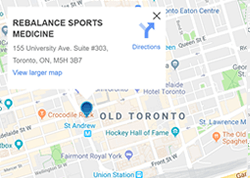Tips to Integrate Exercise Into your Busy Life
 Exercise has been proven to have a wide variety of benefits from improving mood, sleep, concentration, energy and strengthening the immune system1. A 2016 study by Ekelund,U. et al. concluded that 60 minutes of moderate intensity activity can decrease the mortality risk associated with 8 hrs of sitting/ inactivity2.
Exercise has been proven to have a wide variety of benefits from improving mood, sleep, concentration, energy and strengthening the immune system1. A 2016 study by Ekelund,U. et al. concluded that 60 minutes of moderate intensity activity can decrease the mortality risk associated with 8 hrs of sitting/ inactivity2.
“I don’t have time to exercise today.”
“I have too much work to do.”
“I’m too tired to workout.”
We’ve all made these excuses before and talked ourselves out of going to the gym or doing a home workout. With our busy schedules of zoom meetings, running errands, cooking dinner, studying – the million-dollar question is ‘Where can I fit exercise into my already packed schedule’?
Here are a few tips to integrate exercise into your busy life:
1. Schedule it!
Make exercise a priority by blocking off time in your schedule. It can be 10 minutes during your lunch break, or 30 minutes at the end of your workday. Start off by keeping it at a consistent day & time repeated weekly until it becomes a habit. Once it’s in your schedule, make it a non-negotiable and schedule other tasks around this set time.
2. Start Small!
“Physical activity is defined as any bodily movement produced by skeletal muscles that results in energy expenditure.”3. Whether you have 10 mins or 1 hour once a week, any physical movement is beneficial. It can simply be getting up from your desk every hour to do 10 squats & lunges, 10 jumping jacks before every meeting or a 15 min yoga video at the end of the day to decompress and relax. Mix it up with a walk around the block or climbing a few set of stairs to keep your blocked exercise time interesting and exciting. Once the exercises become easy, you can slowly increase the duration by 5-10 minutes and frequency up to 2-3x/week.
3. Equipment & Clothing
If you look and feel the part, you will be more inclined to perform that activity. Simply wearing your workout clothes before you plan to workout helps you get into the right mindset and motivated to exercise. Having equipment in plain sight is like a large sticky note constantly reminding you to use the equipment and exercise.
4. Accountability
Creating an attainable monthly goal and using an activity tracker is a great visual for making progress towards your goal. Once you get the ball rolling, every workout added to the activity tracker feels easier and another step closer to your goal. Remember to reward yourself when you achieve your goal! Furthermore, make a group with a few friends to encourage and motivate each other to reach a collective goal together. Activity apps such as Strava and Optimity are great to help keep you accountable with steps goals, finisher badges and rewards to keep you motivated.
5. Fitness Watches & Step Counters
We seem to get more and more attached to our technological devices, so while we’re scrolling through social media, why not have it send reminders to exercise? Fitness watches have been great at setting movement breaks when there’s been minimal activity for a set period of time. In addition, it can send reminders to complete your targeted step count for the day. These small but constant reminders are what we need when we get distracted and are about to put off exercising for the day.
If you’re unsure of where to start or if you are not sure you are doing exercises correctly, a thorough assessment with a Physiotherapist can help get you started. Your Physiotherapist will analyze your movement patterns, provide you with a targeted exercise program, and work collaboratively with you to create a plan to reach your goals. The exercise program will be tailored specifically to your schedule and help keep you accountable to stick to a routine.
References:
- Nieman, D. & Wentz, L. (2019) “The compelling link between physical activity and the body’s defense system.”J Sport Health Sci. 2019 May;8(3):201-217
- Ekelund, Ulf et al. (2016) “Does physical activity attenuate, or even eliminate, the detrimental association of sitting time with mortality? A harmonized meta-analysis of data from more than 1 million men and women.” Lancet 2016; 388: 1302–10
- Caspersen, CJ et al, (1985) “Physical activity, exercise, and physical fitness: definitions and distinctions for health-related research.” Public Health Rep. 1985 Mar-Apr; 100(2): 126–131
Helen Suen
Helen Suen is a registered physiotherapist practicing at Rebalance Sports Medicine in downtown Toronto.



 What to Expect From Your First Physiotherapy Visit
What to Expect From Your First Physiotherapy Visit The Benefits of Fascial Stretch Therapy [Demo]
The Benefits of Fascial Stretch Therapy [Demo] How Does Physiotherapy Work?
How Does Physiotherapy Work? Best Exercises for Low Back Pain
Best Exercises for Low Back Pain